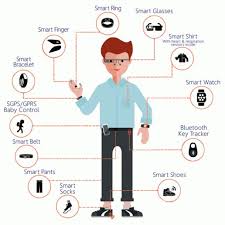The Latest in IT Technology: Innovations Shaping the Future
In the fast-paced world of Information Technology, staying updated with the latest trends is crucial for businesses and individuals alike. As we progress further into the digital age, several key technologies are emerging that promise to transform industries and redefine how we interact with technology.
Artificial Intelligence and Machine Learning
Artificial Intelligence (AI) and Machine Learning (ML) continue to be at the forefront of technological innovation. AI is being integrated into various applications to enhance user experience, automate processes, and provide insightful analytics. From virtual assistants like Siri and Alexa to advanced data analytics tools, AI is making systems smarter and more efficient.
Machine Learning, a subset of AI, is enabling computers to learn from data without being explicitly programmed. This capability is particularly useful in areas such as predictive analytics, natural language processing, and image recognition. Companies are leveraging ML algorithms to gain a competitive edge by predicting market trends and consumer behaviour more accurately.
5G Technology
The rollout of 5G networks is revolutionising mobile connectivity by offering significantly faster data speeds and lower latency compared to its predecessors. This advancement is not only enhancing mobile internet experiences but also paving the way for new technologies such as Internet of Things (IoT) devices, smart cities, and augmented reality applications.
With 5G’s ability to support a massive number of connected devices simultaneously, industries like healthcare, automotive, and manufacturing are exploring innovative solutions that were previously not feasible with older network standards.
Blockchain Technology
Originally known for powering cryptocurrencies like Bitcoin, blockchain technology has now found applications beyond digital currencies. Its decentralised nature ensures transparency and security in transactions, making it ideal for use in supply chain management, voting systems, and secure data sharing.
Many organisations are adopting blockchain technology to enhance trustworthiness in their operations by providing an immutable record of transactions that can be audited independently without risk of tampering.
Edge Computing
As IoT devices proliferate across various sectors, edge computing is gaining momentum as a means to process data closer to its source rather than relying on centralised cloud servers. This approach reduces latency issues significantly while improving real-time data processing capabilities.
Edge computing is particularly beneficial in scenarios where immediate data analysis is critical—such as autonomous vehicles or remote healthcare monitoring systems—ensuring faster response times while alleviating bandwidth demands on centralised networks.
Quantum Computing
Though still in its nascent stages compared to other technologies mentioned here; quantum computing holds immense potential due its ability perform complex calculations exponentially faster than classical computers could ever achieve alone.
This technology promises breakthroughs across numerous fields including cryptography (by breaking existing encryption methods), drug discovery (through molecular simulations), financial modelling (for risk assessment) among others—ushering new era computational power previously thought impossible attain using traditional methods alone!
The Future Awaits
The landscape IT continues evolve rapidly thanks these groundbreaking advancements pushing boundaries what’s possible today! Staying abreast latest developments crucial navigating successfully through ever-changing digital world embracing opportunities they bring along way! Whether you’re business leader looking adopt cutting-edge solutions improve efficiency productivity or tech enthusiast eager explore exciting possibilities future holds there’s no denying impact these innovations will have shaping tomorrow’s society!
Top 7 Benefits of Cutting-Edge IT Technology: Boosting Efficiency, Security, and Growth
- Enhanced efficiency and productivity through automation.
- Improved data security measures with advanced encryption technologies.
- Seamless connectivity across devices and networks for enhanced collaboration.
- Greater insights and decision-making capabilities with advanced analytics tools.
- Enhanced user experiences through personalised and interactive interfaces.
- Cost savings through streamlined processes and resource optimisation.
- Innovative solutions driving business growth and competitive advantage.
Challenges of Modern IT Technology: Privacy, Inequality, Security, Employment, Environment, and Dependence
- 1. Privacy Concerns
- 2. Digital Divide
- 3. Cybersecurity Threats
- 4. Job Displacement
- 5. Environmental Impact
- 6. Technological Dependence
Enhanced efficiency and productivity through automation.
The latest IT technology offers a significant advantage in enhancing efficiency and productivity through automation. By automating repetitive tasks and streamlining processes, businesses can save time and resources, allowing employees to focus on more strategic and creative endeavours. From automated customer service chatbots to data entry automation, organisations can achieve higher levels of productivity while reducing human error. This not only boosts operational efficiency but also improves overall output quality, enabling businesses to stay competitive in a rapidly evolving digital landscape.
Improved data security measures with advanced encryption technologies.
In the realm of Information Technology, one notable advantage of the latest advancements is the enhanced data security measures facilitated by advanced encryption technologies. These cutting-edge encryption methods play a pivotal role in safeguarding sensitive information from unauthorised access and potential cyber threats. By implementing robust encryption protocols, organisations can fortify their data protection strategies, ensuring confidentiality and integrity of critical data assets. This heightened level of security not only instils trust among users and stakeholders but also mitigates the risks associated with data breaches, bolstering overall cybersecurity posture in an increasingly digital landscape.
Seamless connectivity across devices and networks for enhanced collaboration.
The advent of the latest IT technology has ushered in a new era of seamless connectivity across devices and networks, significantly enhancing collaboration among individuals and organisations. With the ability to effortlessly share information, communicate in real-time, and work together regardless of physical location or device used, this advancement has revolutionised how teams collaborate and innovate. From cloud-based platforms to unified communication tools, the seamless integration of technology enables smoother workflows, improved productivity, and more effective teamwork in today’s interconnected digital landscape.
Greater insights and decision-making capabilities with advanced analytics tools.
With the latest IT technology advancements, businesses now have access to advanced analytics tools that provide greater insights into their operations and customer behaviour. By harnessing the power of data analytics, organisations can make more informed decisions based on real-time information and predictive analysis. These tools enable companies to identify trends, patterns, and opportunities that may have gone unnoticed before, ultimately enhancing their decision-making capabilities and driving strategic growth in a competitive digital landscape.
Enhanced user experiences through personalised and interactive interfaces.
The latest IT technology offers a significant advantage in enhancing user experiences through personalised and interactive interfaces. By leveraging advanced algorithms and data analytics, technology can now tailor content and interactions to individual preferences, creating a more engaging and tailored user journey. From personalised recommendations on streaming platforms to interactive chatbots providing real-time assistance, these advancements not only make technology more intuitive but also foster deeper connections between users and digital platforms. This level of personalisation not only improves user satisfaction but also increases engagement and loyalty towards the products or services offered.
Cost savings through streamlined processes and resource optimisation.
The latest IT technology offers significant cost savings through streamlined processes and resource optimisation. By leveraging advanced automation tools, businesses can eliminate manual tasks, reduce operational inefficiencies, and enhance productivity. Optimising resources such as cloud computing services allows organisations to scale their infrastructure based on demand, leading to cost-effective solutions without compromising performance. This strategic approach not only improves the bottom line but also empowers companies to allocate resources more efficiently, ultimately driving sustainable growth and competitiveness in today’s dynamic market landscape.
Innovative solutions driving business growth and competitive advantage.
Innovative solutions stemming from the latest IT technology are playing a pivotal role in driving business growth and securing competitive advantage in today’s dynamic market landscape. Businesses that harness these cutting-edge technologies can streamline operations, enhance productivity, and deliver superior customer experiences. By leveraging innovative IT solutions such as artificial intelligence, data analytics, and cloud computing, organisations can make informed decisions faster, adapt to market changes more efficiently, and stay ahead of the competition. Embracing these advancements not only boosts operational efficiency but also opens up new opportunities for expansion and differentiation in an increasingly digital-centric world.
1. Privacy Concerns
The rapid advancement of IT technology has sparked growing concerns surrounding data privacy and security. With the increasing collection and storage of personal information, individuals are becoming more vulnerable to potential breaches and misuse of their data. From online transactions to social media interactions, the digital footprint left behind is a treasure trove for cyber threats and malicious actors. As technology continues to evolve, it is essential for users, businesses, and policymakers to address these privacy concerns proactively to safeguard sensitive information and uphold trust in the digital ecosystem.
2. Digital Divide
The digital age brings with it a significant con: the digital divide. This gap in access to the latest IT technology creates disparities between individuals and communities, where some can fully harness the benefits of technological advancements while others are left at a disadvantage. As technology continues to advance rapidly, bridging this digital gap becomes crucial to ensure that everyone has equal opportunities to thrive in an increasingly digital world.
3. Cybersecurity Threats
With the rapid advancements in IT technology, one significant concern that arises is the escalating cybersecurity threats. As IT systems become more intricate and interconnected, the vulnerability to cyberattacks and data breaches intensifies, posing a grave risk to the security of sensitive information. The sophistication of modern cyber threats demands constant vigilance and robust security measures to safeguard valuable data from malicious actors seeking to exploit vulnerabilities in the digital landscape.
4. Job Displacement
The rapid advancement of automation and AI technologies, while offering numerous benefits, also presents significant challenges, particularly in the realm of employment. As these technologies become more sophisticated and capable of performing tasks traditionally carried out by humans, there is an increasing risk of job displacement across various industries. Sectors such as manufacturing, retail, and even some areas of service are witnessing a shift where machines and algorithms can perform roles more efficiently and cost-effectively than human workers. This transition not only threatens the livelihoods of those in affected positions but also necessitates a focus on reskilling and upskilling the workforce to prepare for new opportunities that emerge in the evolving job market. Without proactive measures to address these changes, there is a risk of widening economic disparities and increased unemployment rates for those unable to transition into new roles within the digital economy.
5. Environmental Impact
The rapid advancement of IT technology, while bringing numerous benefits, also comes with its own set of challenges. One significant concern is the environmental impact associated with the production and disposal of IT devices. The increasing demand for electronic gadgets leads to a surge in electronic waste, creating sustainability issues and posing challenges in terms of recycling. Proper disposal and recycling of these devices are crucial to mitigate the environmental impact and promote a more sustainable approach towards technology consumption.
6. Technological Dependence
Technological Dependence is a significant drawback of the latest IT technology trends. Excessive reliance on IT solutions can result in a decline in human interaction as individuals increasingly turn to digital means for communication and socialisation. Moreover, an over-reliance on automated solutions may diminish critical thinking skills, as users become accustomed to relying on pre-programmed algorithms for decision-making processes. This dependency on technology poses a risk of disconnecting individuals from real-world experiences and human connections, highlighting the importance of maintaining a balance between technological advancements and traditional human interactions.




